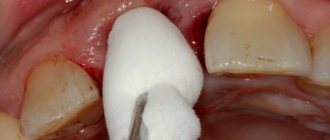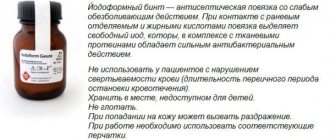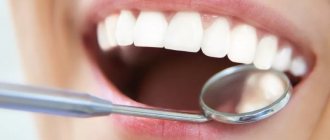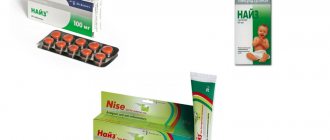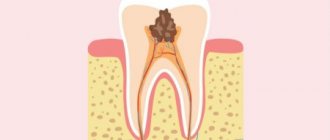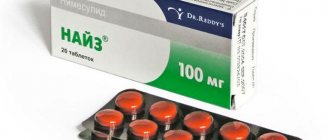27.11.2019
Tooth pulpitis is treated in two main ways - biological and surgical. The method of therapy is selected depending on the severity of the symptoms, the type of pathology, as well as the progression of the inflammatory process. Treatment is prescribed based on the results of the preliminary examination. The specialist always faces the task of saving the patient from unpleasant sensations and, if possible, preserving the damaged tooth, so everything will depend on the situation.
Content:
- When is a non-permanent filling indicated?
- Why does a tooth with a temporary filling hurt?
- When to sound the alarm
- What to do if a tooth hurts under a temporary filling
- Preventive measures
Most often, people rush to the dental clinic because of pain.
Naturally, every person hopes that he will return home with a healthy tooth. Unfortunately, this is not always the case. Often in dental practice there are situations when the doctor has to put a temporary filling instead of a permanent one. It is distinguished by its low cost and loose structure. It is loosely held in the carious cavity and quite quickly falls out on its own or decreases in volume. These features are due to the fact that the temporary filling material must be easily removed. The problems it solves:
- protection of the carious “hollow” from the accumulation of food debris and the penetration of pathogenic bacteria;
- preventing premature loss of medication from the “hole”.
Advantages of hot filling
An experienced doctor can perform equally high-quality fillings using any of these methods (“cold” or “hot”). However, the hot gutta-percha method is still less labor-intensive, filling occurs faster, and the probability of error is even lower.
But still, the main advantage of hot filling is the ability to fill all, even microscopic microchannels, which the cold gutta-percha method is not able to fill. Each tooth is unique, as are its root canals. Seeing them, an experienced dentist will always recommend to the patient the optimal filling method.
Why does a tooth with a temporary filling hurt?
Often the temporary filling hurts. Among the main reasons for this problem are:
- Serious damage to dentin tissue. Injuries to dentinal tissues when treating a carious area with a drill cannot be avoided. Dentin has the ability to heal itself, but this does not happen overnight. Soon everything will return to normal - the patient just needs to be patient.
- Overheating of the dentinal zone. It happens if the doctor worked with the drill for too long and did not use water cooling in the process of cleaning the “hole”. It may also be a consequence of the use of faulty medical equipment.
- The filling height is too high. Then, when pressing on the tooth, acute pain appears. You shouldn't tolerate it. The most reasonable thing is to make an appointment with a doctor and ask him to remove the excess material. In general, this reason is rare, since before sending the patient home, a good specialist always makes sure that the material is standing properly and does not take up excessive space.
- Exceeding the prescribed treatment period. The doctor clearly announces when you need to come for a follow-up appointment to remove the stored medicine. But some people ignore such instructions and walk with the material longer. Then there is a destructive effect on the tissues of the unit, aching or acute pain appears. A medicinal composition whose service life has long expired becomes toxic. It disrupts metabolic processes occurring in local tissues. Promotes crown destruction. Cracks form on the surface of the latter.
- Individual intolerance to the prescribed filling composition. Sometimes in dental practice there are allergies to the drugs used. Then, after laying the material, swelling appears. The tooth starts to hurt.
- Partial destruction of the seal. The formed depression may be very small and, quite possibly, the person will not even notice that any changes have occurred to his tooth. Meanwhile, pathogenic organisms will begin to penetrate through the hole that appears into the deep tissues. This will cause inflammation. The unit will begin to react painfully to temperature changes, spicy, salty and sour foods.
It is important to understand what is causing the pain symptoms. The patient cannot do this on his own, since this involves an in-person examination in the dentist’s office. You need to make an appointment with a doctor as soon as possible and undergo the treatment he suggests.
Manufacturing materials
When choosing a composition for temporary closure of a carious cavity, the following are taken into account:
- size of the lesion;
- diagnosis;
- expected duration of treatment;
- the patient is allergic to medications.
Most often, doctors use the following intermediate-acting filling solutions:
- From kaolin and zinc sulfate. The mixture allows you to partially restore dentin - the hard crown part located under the enamel.
- Polycarboxylate. Low-toxic cement used to fix a crown, inlay or dental bridge. Can act as an insulating gasket when installing amalgam and cement elements.
- Karyosan. Zinc oxyeugenol cement, formed by zinc oxide and eugenol. Shows analgesic and antiseptic properties. Used to disinfect canals and relieve inflammation.
- Vinoxol. Includes zinc oxide and a solution of polystyrene in guaiacol. High-quality artificial dentin that can withstand chewing load for one to two months.
- Glass ionomer cement. Suitable if you need to fix dentures for a short period of time.
When to sound the alarm
Is it normal for a tooth with a temporary filling to hurt a lot? No. Mild discomfort is possible, but long-lasting acute pain is a reason to visit the doctor again. However, this should be done as soon as possible. It is especially dangerous if a person’s well-being worsens at night, swelling has formed or a purulent “bump” has appeared - all this may indicate the rapid progression of dangerous complications.
What kind of pain can there be and what problem does it indicate:
- The tooth aches constantly. The state of health after the last visit to the dentist does not worsen, but does not improve either. This is possible if you are allergic to a dental composition, use too high a dose of the drug (intoxication occurred due to an overdose), or use a very low dose of the drug (the infection could not be stopped and it continues to actively progress).
- Discomfort appears only when pressing on the diseased unit. Here one should suspect traumatic damage to the periodontium due to the artificial overestimation of the dental crown.
- Unbearable pain appears even with a slight touch to the tooth. Perhaps a fragment of a medical instrument remains in the canal or acute periodontitis has developed.
- There are attacks of pain. This happens when the purulent form of pulpitis is advanced.
How to eliminate pain?
While the temporary filling is in place, it is important to follow all medical recommendations. To relieve unpleasant symptoms, a specialist may recommend combined analgesics or drugs with paracetamol and ibuprofen (Panadol, Efferalgan, Ibufen, Nise, etc.).
Rinsing with a soda solution will help soothe the tooth. Often, alcohol tinctures, which have a pronounced antiseptic effect, are used for this purpose.
You can cope with pain using traditional medicine:
- Aloe applications. A cut fresh leaf of the plant is applied to the sore spot.
- Applications from herbal tinctures. You can buy a tincture of calendula, mint or valerian at the pharmacy, then soak a bandage or cotton wool in it and apply it to the tooth.
- Lotions made from propolis tincture (2%). Keep the swab soaked in the medicine on the tooth for several minutes. You can also prepare a rinse solution by adding 3 tsp to a glass of warm boiled water. alcohol solution.
- Rinse solution made from chamomile infusion. Pour a glass of boiling water over the dry herb (2 tbsp) and leave for about half an hour. Rinse your mouth with the resulting decoction 3 times a day.
You can eliminate toothache by lubricating your gums with clove essential oil or placing a piece of unsalted lard on the sore tooth. Massaging your earlobes will also help you forget that your tooth hurts. It is enough to massage the earlobe for 5 minutes.
What to do if a tooth hurts under a temporary filling
The first thing a patient should do is get qualified medical care. Remember: for acute pain, all dentists accept appointments without an appointment. If for some reason a visit to the dentist has to be postponed for one or two days (for example, discomfort occurred on the weekend), you will have to self-medicate. This may include:
- Taking a safe analgesic. It is advisable to consult with your dentist in advance about acceptable medications that reduce pain symptoms. Such drugs should always be selected on an individual basis, as they have a large number of side effects and contraindications.
- Rinsing the mouth with a solution of salt or soda. Decoctions of chamomile and sage have proven themselves well. It is also acceptable to periodically apply an anesthetic dental gel to the gums.
It is possible that after the examination the specialist will say that there is no cause for concern. Then the patient will have to complete the prescribed period, relieving pain with analgesics.
Under no circumstances should you force the process of replacing a temporary filling material with a permanent one. This can lead to serious complications in the future. Then you will have to unseal and carry out treatment from the very beginning.
What painkillers can be taken in the postoperative period?
Most often, when local anesthesia wears off after a tooth extraction procedure, the patient feels pain in the area of intervention. The best way to eliminate pain is to take NSAIDs. This group of drugs is the most effective in eliminating toothache.
- The drugs "Nurofen" or "Ibuprofen" cope well with pain after surgery. It is necessary to take the drug 500-800 mg three to four times a day, depending on the intensity of the pain.
- "Ketorol" is one of the most effective and powerful drugs from the NSAID group, which can eliminate pain after the procedure in a fairly short time. It is also used two tablets three to four times throughout the day.
You can take Nurofen, Ketorol
Preventive measures
In order for the process of preparing for the main treatment to proceed without unpleasant surprises and dangerous complications, you must follow simple rules:
- Try not to put stress on the sealed unit. This means that you should chew food from the “healthy side”. Under no circumstances should you chew on foreign objects. Also, intensive rinsing should not be done unless prescribed by a doctor.
- Maintain good oral hygiene. It is necessary to carry out hygiene measures in the morning and evening. Inflamed areas of the gums can be treated with a brush with soft bristles.
- Check the temporary filling for cracks and chips. If they appear, a re-sealing should be carried out. Otherwise, by the time the permanent material is installed, there may be nothing left of the dental crown - it will collapse under the aggressive influence of pathogens.
Watch your tooth filled with a temporary filling carefully. Then you will avoid many problems.
How long does it take for treatment?
How long does it take to treat the disease to get a positive result from therapy? In this situation, everything will depend on many factors. First of all, attention is paid to the stage of the disease and the inflammatory process. The general condition of the patient and other severe symptoms must also be taken into account. Do not forget about the destructive process and the possibility of restoring a damaged tooth.
If it is possible to leave the pulp and not remove the tooth, then a conservative treatment method is used, which includes several visits to the dental office. If a patient is diagnosed with an advanced stage of pulpitis, it is recommended to undergo surgical treatment, which also involves several visits to a specialist.
Why do they place a temporary filling for pulpitis?
Temporary filling is recommended for conservative treatment of pulpitis and caries. It is installed in order to prevent the leakage of the anti-inflammatory drug from the root canal, as well as to prevent the entry of pathogenic microflora and pieces of food.
What medicine is put into the tooth for pulpitis?
It is impossible to treat tooth pulpitis without the use of various drugs. The medicine is placed under the filling to eliminate the infection and inflammatory process.
Various anti-inflammatory drugs may be used. Very often, arsenic is placed in the tooth to kill the nerve and numb the problem area.
Types of temporary fillings
You cannot do without a temporary filling in the following cases:
- For conservative treatment of not too advanced pulpitis and advanced caries. After drilling out the inflammatory focus and treating the root canals, the tooth cavity is filled with anti-inflammatory drugs, and a filling is placed on top. This is necessary so that the drug does not leak out and that microbes and pieces of food do not get into the diseased tooth.
- For diagnosis in deep caries, when it is unclear whether the nerve is affected. They put a filling with medicine and watch the tooth - if it continues to hurt, most likely it is pulpitis.
- In the treatment of pulpitis, if there is a need to remove the nerve. Then the treatment is carried out in 2 steps: first, a filling is placed with arsenic or other, more gentle devitalizing drugs, and after the death of the nerve, treatment is carried out.
- For prosthetics and restoration to protect teeth while permanent structures are being made.
Installing a temporary filling is absolutely safe, except in cases where individual allergic reactions to filling materials are observed.
